weight SKODA SUPERB 2014 2.G / (B6/3T) User Guide
[x] Cancel search | Manufacturer: SKODA, Model Year: 2014, Model line: SUPERB, Model: SKODA SUPERB 2014 2.G / (B6/3T)Pages: 246, PDF Size: 17.16 MB
Page 160 of 246
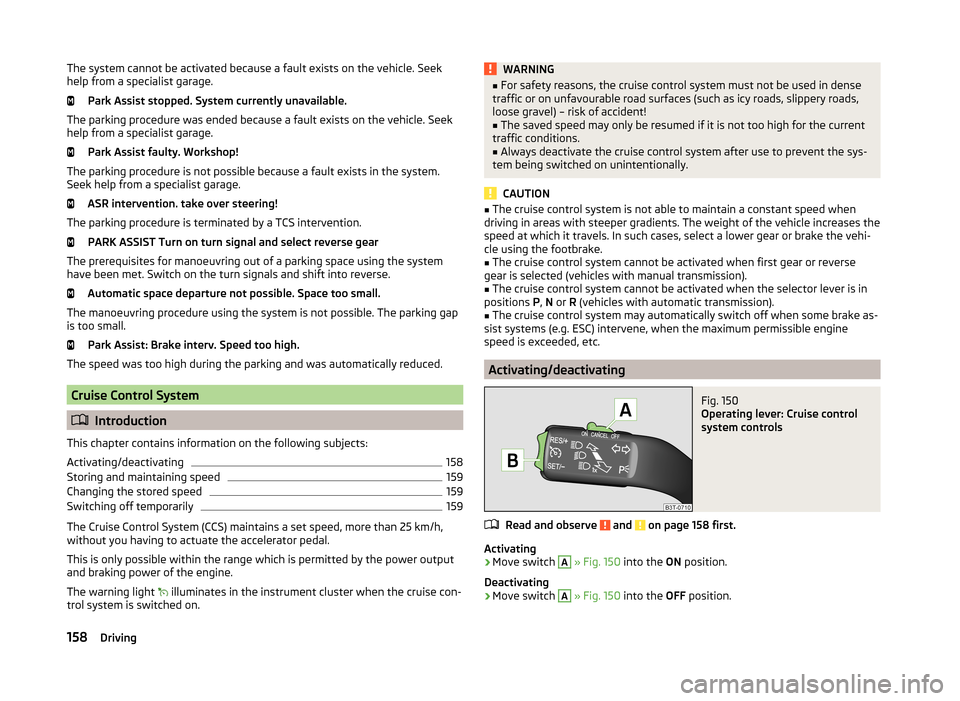
The system cannot be activated because a fault exists on the vehicle. Seek
help from a specialist garage.
Park Assist stopped. System currently unavailable.
The parking procedure was ended because a fault exists on the vehicle. Seek
help from a specialist garage.
Park Assist faulty. Workshop!
The parking procedure is not possible because a fault exists in the system.
Seek help from a specialist garage.
ASR intervention. take over steering!
The parking procedure is terminated by a TCS intervention. PARK ASSIST Turn on turn signal and select reverse gear
The prerequisites for manoeuvring out of a parking space using the system
have been met. Switch on the turn signals and shift into reverse.
Automatic space departure not possible. Space too small.
The manoeuvring procedure using the system is not possible. The parking gap
is too small.
Park Assist: Brake interv. Speed too high.
The speed was too high during the parking and was automatically reduced.
Cruise Control System
Introduction
This chapter contains information on the following subjects:
Activating/deactivating
158
Storing and maintaining speed
159
Changing the stored speed
159
Switching off temporarily
159
The Cruise Control System (CCS) maintains a set speed, more than 25 km/h,
without you having to actuate the accelerator pedal.
This is only possible within the range which is permitted by the power output and braking power of the engine.
The warning light illuminates in the instrument cluster when the cruise con-
trol system is switched on.
WARNING■ For safety reasons, the cruise control system must not be used in dense
traffic or on unfavourable road surfaces (such as icy roads, slippery roads,
loose gravel) – risk of accident!■
The saved speed may only be resumed if it is not too high for the current
traffic conditions.
■
Always deactivate the cruise control system after use to prevent the sys-
tem being switched on unintentionally.
CAUTION
■ The cruise control system is not able to maintain a constant speed when
driving in areas with steeper gradients. The weight of the vehicle increases the
speed at which it travels. In such cases, select a lower gear or brake the vehi-
cle using the footbrake.■
The cruise control system cannot be activated when first gear or reverse
gear is selected (vehicles with manual transmission).
■
The cruise control system cannot be activated when the selector lever is in
positions P, N or R (vehicles with automatic transmission).
■
The cruise control system may automatically switch off when some brake as-
sist systems (e.g. ESC) intervene, when the maximum permissible engine
speed is exceeded, etc.
Activating/deactivating
Fig. 150
Operating lever: Cruise control
system controls
Read and observe and on page 158 first.
Activating
›
Move switch
A
» Fig. 150 into the ON position.
Deactivating
›
Move switch
A
» Fig. 150 into the OFF position.
158Driving
Page 168 of 246
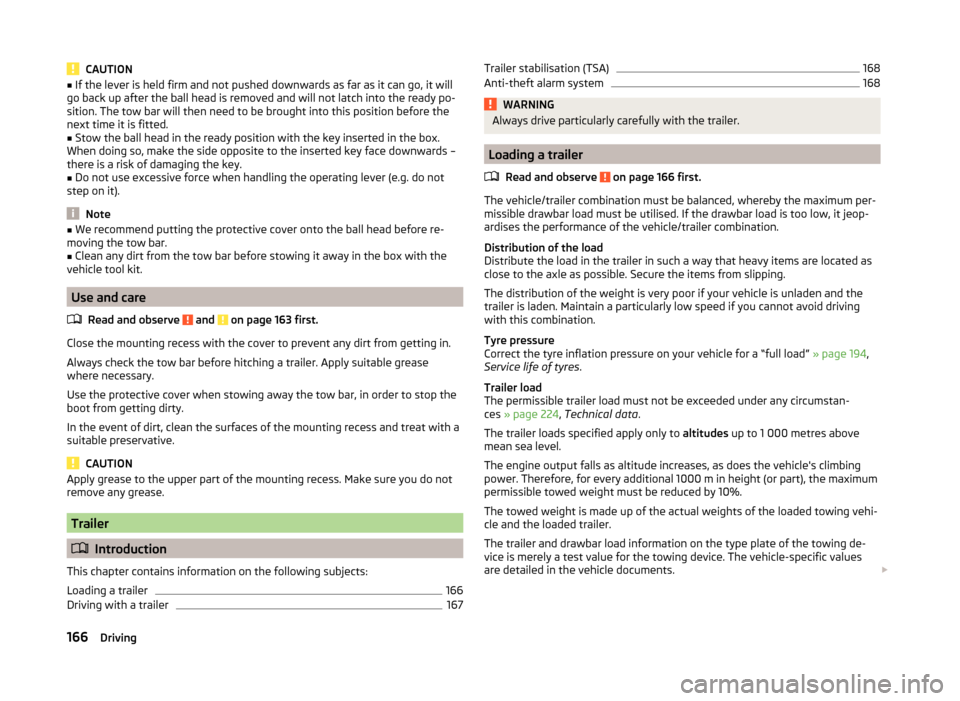
CAUTION■If the lever is held firm and not pushed downwards as far as it can go, it will
go back up after the ball head is removed and will not latch into the ready po-
sition. The tow bar will then need to be brought into this position before the
next time it is fitted.■
Stow the ball head in the ready position with the key inserted in the box.
When doing so, make the side opposite to the inserted key face downwards –
there is a risk of damaging the key.
■
Do not use excessive force when handling the operating lever (e.g. do not
step on it).
Note
■ We recommend putting the protective cover onto the ball head before re-
moving the tow bar.■
Clean any dirt from the tow bar before stowing it away in the box with the
vehicle tool kit.
Use and care
Read and observe
and on page 163 first.
Close the mounting recess with the cover to prevent any dirt from getting in.
Always check the tow bar before hitching a trailer. Apply suitable grease
where necessary.
Use the protective cover when stowing away the tow bar, in order to stop the
boot from getting dirty.
In the event of dirt, clean the surfaces of the mounting recess and treat with a
suitable preservative.
CAUTION
Apply grease to the upper part of the mounting recess. Make sure you do not
remove any grease.
Trailer
Introduction
This chapter contains information on the following subjects:
Loading a trailer
166
Driving with a trailer
167Trailer stabilisation (TSA)168Anti-theft alarm system168WARNINGAlways drive particularly carefully with the trailer.
Loading a trailer
Read and observe
on page 166 first.
The vehicle/trailer combination must be balanced, whereby the maximum per-
missible drawbar load must be utilised. If the drawbar load is too low, it jeop-
ardises the performance of the vehicle/trailer combination.
Distribution of the load
Distribute the load in the trailer in such a way that heavy items are located as
close to the axle as possible. Secure the items from slipping.
The distribution of the weight is very poor if your vehicle is unladen and the
trailer is laden. Maintain a particularly low speed if you cannot avoid driving
with this combination.
Tyre pressure
Correct the tyre inflation pressure on your vehicle for a “full load” » page 194,
Service life of tyres .
Trailer load
The permissible trailer load must not be exceeded under any circumstan- ces » page 224 , Technical data .
The trailer loads specified apply only to altitudes up to 1 000 metres above
mean sea level.
The engine output falls as altitude increases, as does the vehicle's climbing
power. Therefore, for every additional 1000 m in height (or part), the maximum
permissible towed weight must be reduced by 10%.
The towed weight is made up of the actual weights of the loaded towing vehi-
cle and the loaded trailer.
The trailer and drawbar load information on the type plate of the towing de-
vice is merely a test value for the towing device. The vehicle-specific values
are detailed in the vehicle documents.
166Driving
Page 169 of 246
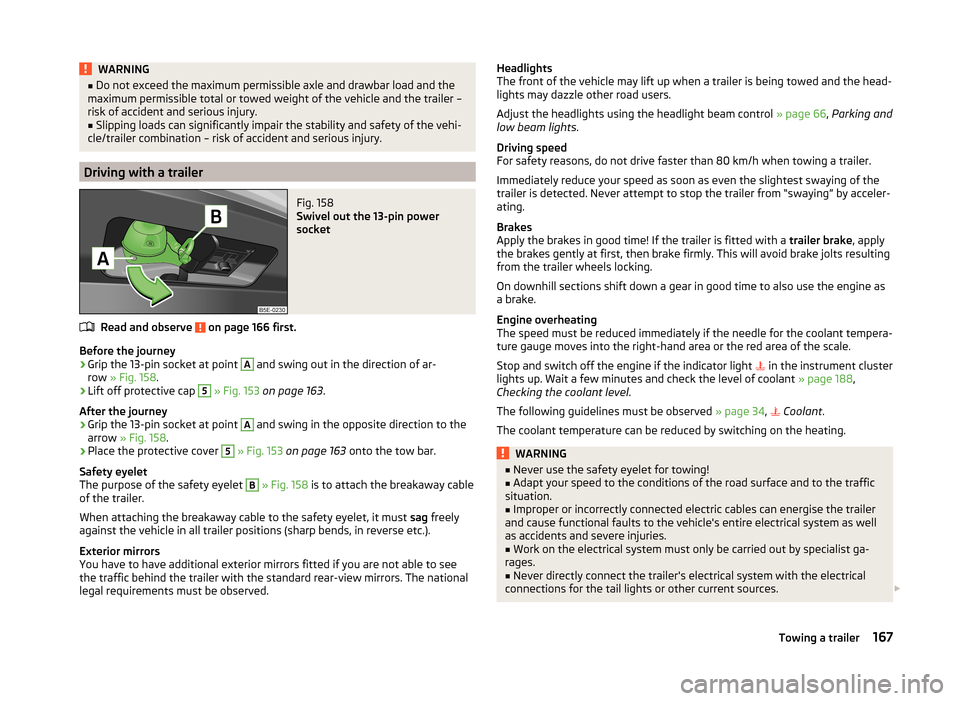
WARNING■Do not exceed the maximum permissible axle and drawbar load and the
maximum permissible total or towed weight of the vehicle and the trailer –
risk of accident and serious injury.■
Slipping loads can significantly impair the stability and safety of the vehi-
cle/trailer combination – risk of accident and serious injury.
Driving with a trailer
Fig. 158
Swivel out the 13-pin power
socket
Read and observe on page 166 first.
Before the journey
›
Grip the 13-pin socket at point
A
and swing out in the direction of ar-
row » Fig. 158 .
›
Lift off protective cap
5
» Fig. 153 on page 163 .
After the journey
›
Grip the 13-pin socket at point
A
and swing in the opposite direction to the
arrow » Fig. 158 .
›
Place the protective cover
5
» Fig. 153 on page 163 onto the tow bar.
Safety eyelet
The purpose of the safety eyelet
B
» Fig. 158 is to attach the breakaway cable
of the trailer.
When attaching the breakaway cable to the safety eyelet, it must sag freely
against the vehicle in all trailer positions (sharp bends, in reverse etc.).
Exterior mirrors
You have to have additional exterior mirrors fitted if you are not able to see
the traffic behind the trailer with the standard rear-view mirrors. The national
legal requirements must be observed.
Headlights
The front of the vehicle may lift up when a trailer is being towed and the head-
lights may dazzle other road users.
Adjust the headlights using the headlight beam control » page 66, Parking and
low beam lights .
Driving speed
For safety reasons, do not drive faster than 80 km/h when towing a trailer.
Immediately reduce your speed as soon as even the slightest swaying of the
trailer is detected. Never attempt to stop the trailer from “swaying” by acceler-
ating.
Brakes
Apply the brakes in good time! If the trailer is fitted with a trailer brake, apply
the brakes gently at first, then brake firmly. This will avoid brake jolts resulting
from the trailer wheels locking.
On downhill sections shift down a gear in good time to also use the engine as
a brake.
Engine overheating
The speed must be reduced immediately if the needle for the coolant tempera-
ture gauge moves into the right-hand area or the red area of the scale.
Stop and switch off the engine if the indicator light in the instrument cluster
lights up. Wait a few minutes and check the level of coolant » page 188,
Checking the coolant level .
The following guidelines must be observed » page 34,
Coolant
.
The coolant temperature can be reduced by switching on the heating.WARNING■ Never use the safety eyelet for towing!■Adapt your speed to the conditions of the road surface and to the traffic
situation.■
Improper or incorrectly connected electric cables can energise the trailer
and cause functional faults to the vehicle's entire electrical system as well
as accidents and severe injuries.
■
Work on the electrical system must only be carried out by specialist ga-
rages.
■
Never directly connect the trailer's electrical system with the electrical
connections for the tail lights or other current sources.
167Towing a trailer
Page 226 of 246

Technical data
Technical data
Vehicle data
Introduction
This chapter contains information on the following subjects:
Vehicle identification data
224
Operating weight and payload
224
Measurement of fuel consumption and CO 2 emissions according to ECE
Regulations and EU Directives
225
Dimensions
226
Vehicle-specific information depending on engine type
227
Multi-purpose vehicles (AF)
231
The details given in the vehicle's technical documentation always take prece-
dence over the details in the Owner's Manual.
The listed performance values were determined without performance-reduc- ing equipment, e.g. air conditioning system.
Vehicle identification data
Fig. 209
Vehicle data sticker/type plate
Vehicle data sticker
The vehicle data sticker » Fig. 209 -
is located on the base of the luggage
compartment and is also fixed into the service schedule.
The vehicle data sticker contains the following data.
Vehicle identification number (VIN)
Vehicle type
Gearbox code/paint number/interior equipment/engine output/engine
code
Partial vehicle description
Type plate
The type plate » Fig. 209 -
is located at the bottom of the B-pillar on the
right driver's side.
The type plate contains the following data. Vehicle identification number (VIN)
Maximum permissible gross weight
Maximum permissible towed weight (towing vehicle and trailer)
Maximum permissible front axle load
Maximum permissible rear axle load
Vehicle identification number (VIN)
The vehicle identification number - VIN (vehicle body number) is stamped into
the engine compartment on the right hand suspension strut dome. This num-
ber is also located on a sign on the lower left hand edge below the windscreen
(together with a VIN bar code), and on the type plate.
Engine number
The engine number (three-digit code letter and serial number) is stamped onto
the engine block.WARNINGDo not exceed the specified maximum permissible weights – risk of acci-
dent and damage!
Operating weight and payload
Operating weight
This value represents the minimum operating weight without additional
weight-increasing equipment such as air conditioning system, spare wheel, or
trailer hitch.
The specified operating weight is for orientation purposes only.
123456789224Technical data
Page 227 of 246
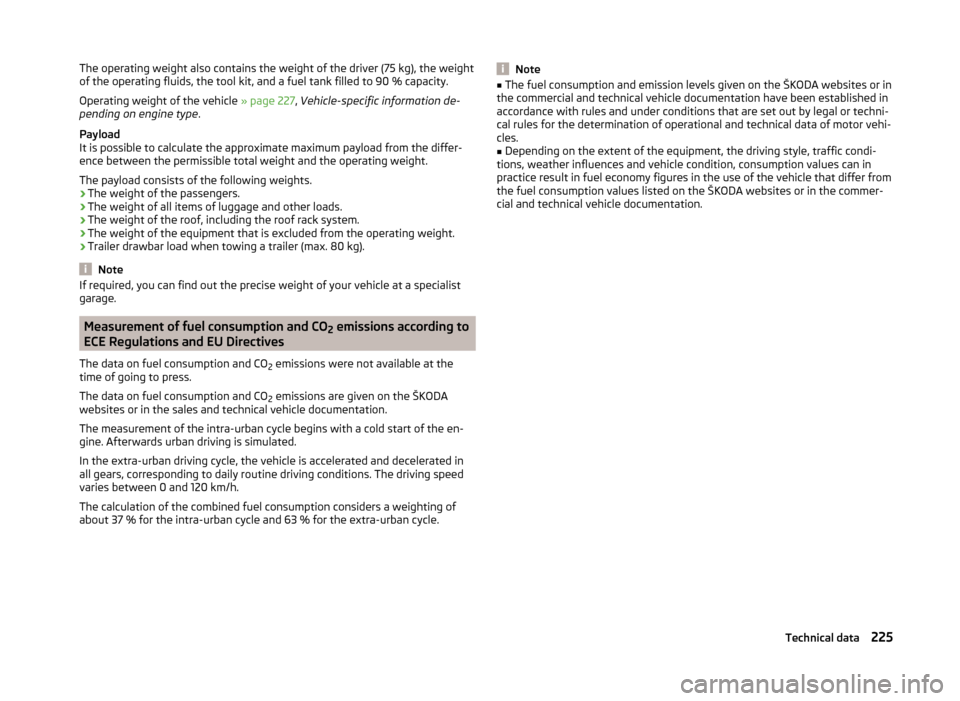
The operating weight also contains the weight of the driver (75 kg), the weight
of the operating fluids, the tool kit, and a fuel tank filled to 90 % capacity.
Operating weight of the vehicle » page 227, Vehicle-specific information de-
pending on engine type .
Payload
It is possible to calculate the approximate maximum payload from the differ-
ence between the permissible total weight and the operating weight.
The payload consists of the following weights.
› The weight of the passengers.
› The weight of all items of luggage and other loads.
› The weight of the roof, including the roof rack system.
› The weight of the equipment that is excluded from the operating weight.
› Trailer drawbar load when towing a trailer (max. 80 kg).
Note
If required, you can find out the precise weight of your vehicle at a specialist
garage.
Measurement of fuel consumption and CO 2 emissions according to
ECE Regulations and EU Directives
The data on fuel consumption and CO 2 emissions were not available at the
time of going to press.
The data on fuel consumption and CO 2 emissions are given on the ŠKODA
websites or in the sales and technical vehicle documentation.
The measurement of the intra-urban cycle begins with a cold start of the en-
gine. Afterwards urban driving is simulated.
In the extra-urban driving cycle, the vehicle is accelerated and decelerated in
all gears, corresponding to daily routine driving conditions. The driving speed
varies between 0 and 120 km/h.
The calculation of the combined fuel consumption considers a weighting of
about 37 % for the intra-urban cycle and 63 % for the extra-urban cycle.
Note■ The fuel consumption and emission levels given on the ŠKODA websites or in
the commercial and technical vehicle documentation have been established in
accordance with rules and under conditions that are set out by legal or techni-
cal rules for the determination of operational and technical data of motor vehi-
cles.■
Depending on the extent of the equipment, the driving style, traffic condi-
tions, weather influences and vehicle condition, consumption values can in
practice result in fuel economy figures in the use of the vehicle that differ from
the fuel consumption values listed on the ŠKODA websites or in the commer-
cial and technical vehicle documentation.
225Technical data
Page 229 of 246
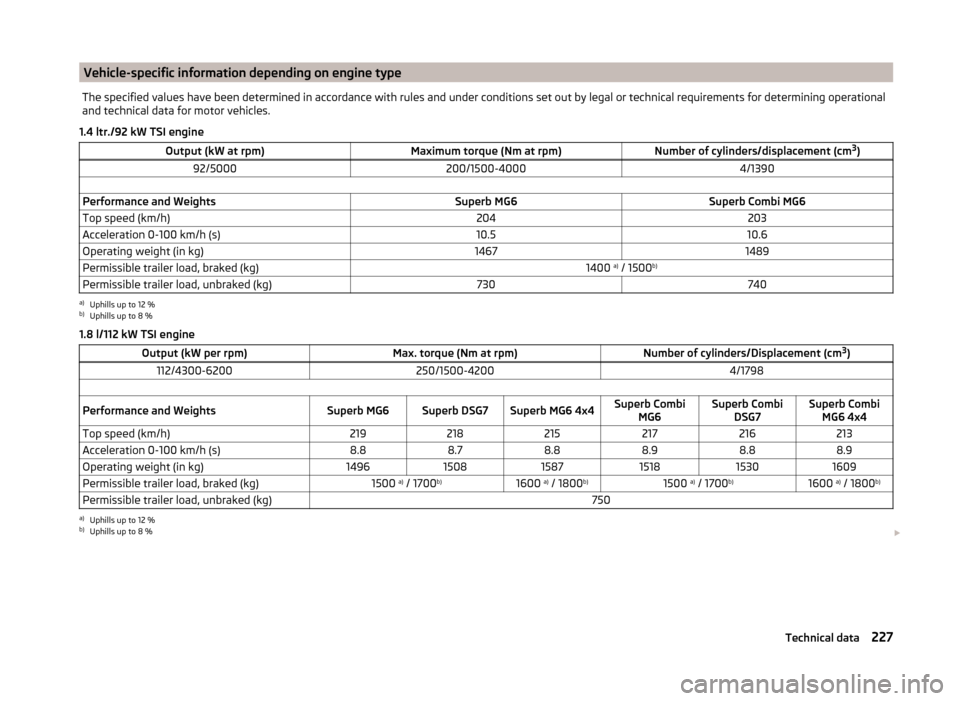
Vehicle-specific information depending on engine typeThe specified values have been determined in accordance with rules and under conditions set out by legal or technical requirements for determining operational
and technical data for motor vehicles.
1.4 ltr./92 kW TSI engine
Output (kW at rpm)Maximum torque (Nm at rpm)Number of cylinders/displacement (cm 3
)92/5000200/1500-40004/1390 Performance and WeightsSuperb MG6Superb Combi MG6Top speed (km/h)204203Acceleration 0-100 km/h (s)10.510.6Operating weight (in kg)14671489Permissible trailer load, braked (kg)1400 a)
/ 1500 b)Permissible trailer load, unbraked (kg)730740a)
Uphills up to 12 %
b)
Uphills up to 8 %
1.8 l/112 kW TSI engine
Output (kW per rpm)Max. torque (Nm at rpm)Number of cylinders/Displacement (cm 3
)112/4300-6200250/1500-42004/1798 Performance and WeightsSuperb MG6Superb DSG7Superb MG6 4x4Superb Combi
MG6Superb CombiDSG7Superb CombiMG6 4x4Top speed (km/h)219218215217216213Acceleration 0-100 km/h (s)8.88.78.88.98.88.9Operating weight (in kg)149615081587151815301609Permissible trailer load, braked (kg)1500 a)
/ 1700 b)1600 a)
/ 1800 b)1500 a)
/ 1700 b)1600 a)
/ 1800 b)Permissible trailer load, unbraked (kg)750a)
Uphills up to 12 %
b)
Uphills up to 8 %
227Technical data
Page 230 of 246
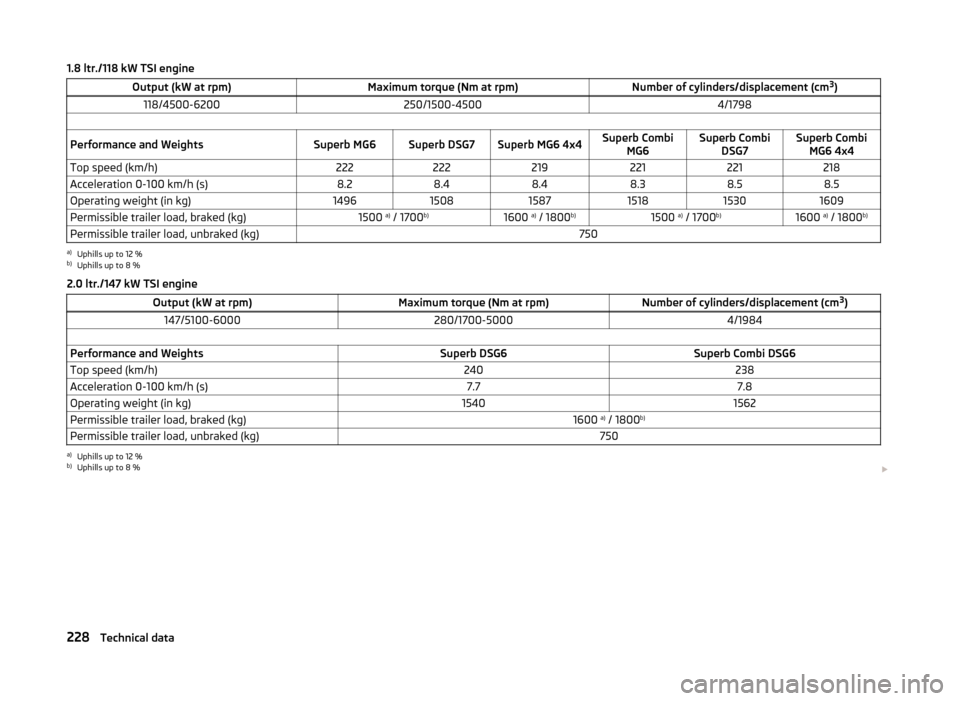
1.8 ltr./118 kW TSI engineOutput (kW at rpm)Maximum torque (Nm at rpm)Number of cylinders/displacement (cm3
)118/4500-6200250/1500-45004/1798 Performance and WeightsSuperb MG6Superb DSG7Superb MG6 4x4Superb Combi
MG6Superb CombiDSG7Superb CombiMG6 4x4Top speed (km/h)222222219221221218Acceleration 0-100 km/h (s)8.28.48.48.38.58.5Operating weight (in kg)149615081587151815301609Permissible trailer load, braked (kg)1500 a)
/ 1700 b)1600 a)
/ 1800 b)1500 a)
/ 1700 b)1600 a)
/ 1800 b)Permissible trailer load, unbraked (kg)750a)
Uphills up to 12 %
b)
Uphills up to 8 %
2.0 ltr./147 kW TSI engine
Output (kW at rpm)Maximum torque (Nm at rpm)Number of cylinders/displacement (cm 3
)147/5100-6000280/1700-50004/1984 Performance and WeightsSuperb DSG6Superb Combi DSG6Top speed (km/h)240238Acceleration 0-100 km/h (s)7.77.8Operating weight (in kg)15401562Permissible trailer load, braked (kg)1600 a)
/ 1800 b)Permissible trailer load, unbraked (kg)750a)
Uphills up to 12 %
b)
Uphills up to 8 %
228Technical data
Page 231 of 246
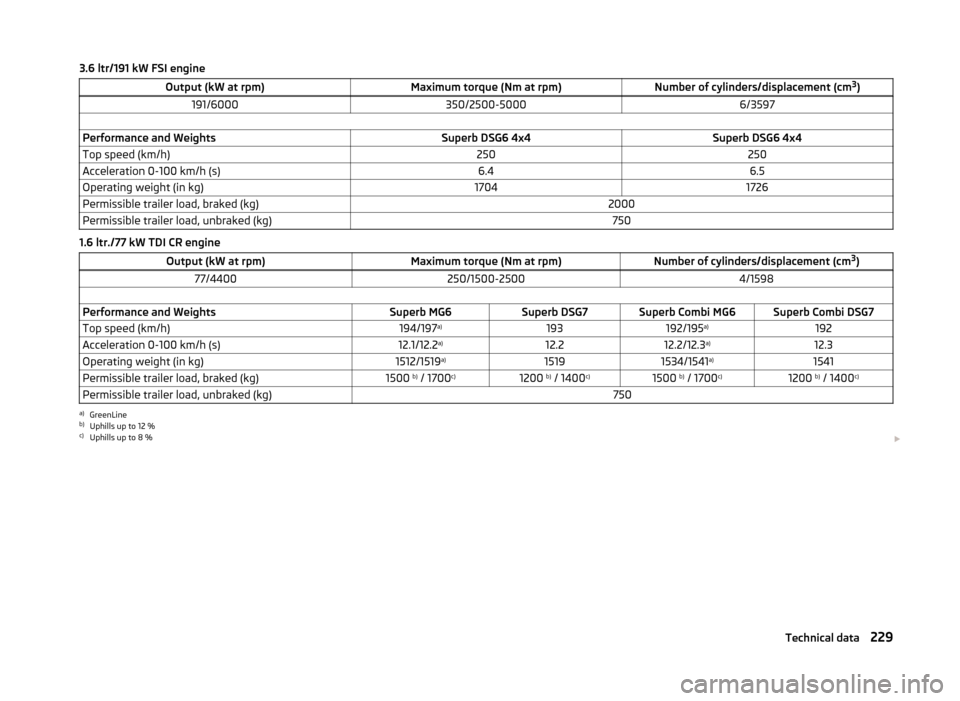
3.6 ltr/191 kW FSI engineOutput (kW at rpm)Maximum torque (Nm at rpm)Number of cylinders/displacement (cm3
)191/6000350/2500-50006/3597 Performance and WeightsSuperb DSG6 4x4Superb DSG6 4x4Top speed (km/h)250250Acceleration 0-100 km/h (s)6.46.5Operating weight (in kg)17041726Permissible trailer load, braked (kg)2000Permissible trailer load, unbraked (kg)750
1.6 ltr./77 kW TDI CR engine
Output (kW at rpm)Maximum torque (Nm at rpm)Number of cylinders/displacement (cm 3
)77/4400250/1500-25004/1598 Performance and WeightsSuperb MG6Superb DSG7Superb Combi MG6Superb Combi DSG7Top speed (km/h)194/197 a)193192/195a)192Acceleration 0-100 km/h (s)12.1/12.2 a)12.212.2/12.3 a)12.3Operating weight (in kg)1512/1519 a)15191534/1541 a)1541Permissible trailer load, braked (kg)1500 b)
/ 1700 c)1200 b)
/ 1400 c)1500 b)
/ 1700 c)1200 b)
/ 1400 c)Permissible trailer load, unbraked (kg)750a)
GreenLine
b)
Uphills up to 12 %
c)
Uphills up to 8 %
229Technical data
Page 232 of 246
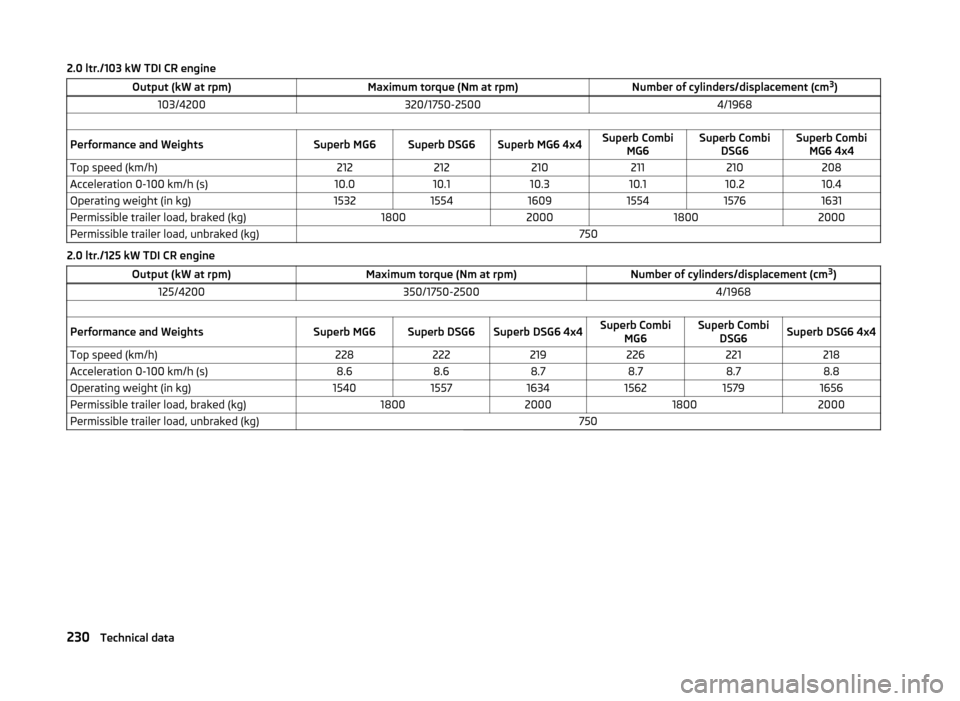
2.0 ltr./103 kW TDI CR engineOutput (kW at rpm)Maximum torque (Nm at rpm)Number of cylinders/displacement (cm3
)103/4200320/1750-25004/1968 Performance and WeightsSuperb MG6Superb DSG6Superb MG6 4x4Superb Combi
MG6Superb CombiDSG6Superb CombiMG6 4x4Top speed (km/h)212212210211210208Acceleration 0-100 km/h (s)10.010.110.310.110.210.4Operating weight (in kg)153215541609155415761631Permissible trailer load, braked (kg)1800200018002000Permissible trailer load, unbraked (kg)750
2.0 ltr./125 kW TDI CR engine
Output (kW at rpm)Maximum torque (Nm at rpm)Number of cylinders/displacement (cm 3
)125/4200350/1750-25004/1968 Performance and WeightsSuperb MG6Superb DSG6Superb DSG6 4x4Superb Combi
MG6Superb CombiDSG6Superb DSG6 4x4Top speed (km/h)228222219226221218Acceleration 0-100 km/h (s)8.68.68.78.78.78.8Operating weight (in kg)154015571634156215791656Permissible trailer load, braked (kg)1800200018002000Permissible trailer load, unbraked (kg)750230Technical data
Page 233 of 246
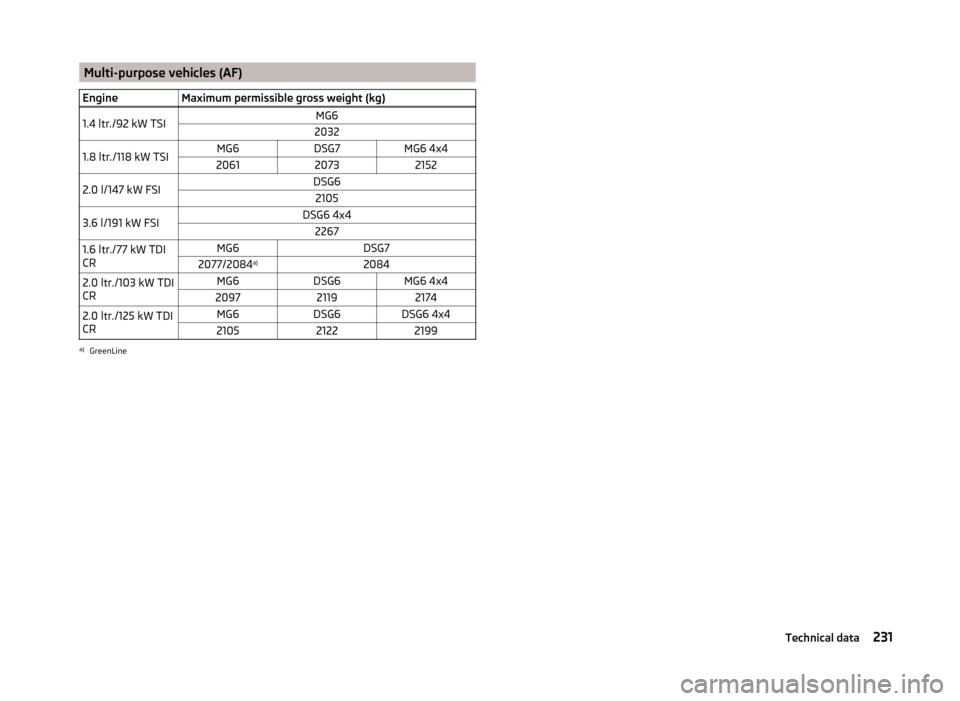
Multi-purpose vehicles (AF)EngineMaximum permissible gross weight (kg)1.4 ltr./92 kW TSIMG620321.8 ltr./118 kW TSIMG6DSG7MG6 4x42061207321522.0 l/147 kW FSIDSG621053.6 l/191 kW FSIDSG6 4x422671.6 ltr./77 kW TDI
CRMG6DSG72077/2084 a)20842.0 ltr./103 kW TDI
CRMG6DSG6MG6 4x42097211921742.0 ltr./125 kW TDI
CRMG6DSG6DSG6 4x4210521222199a)
GreenLine
231Technical data